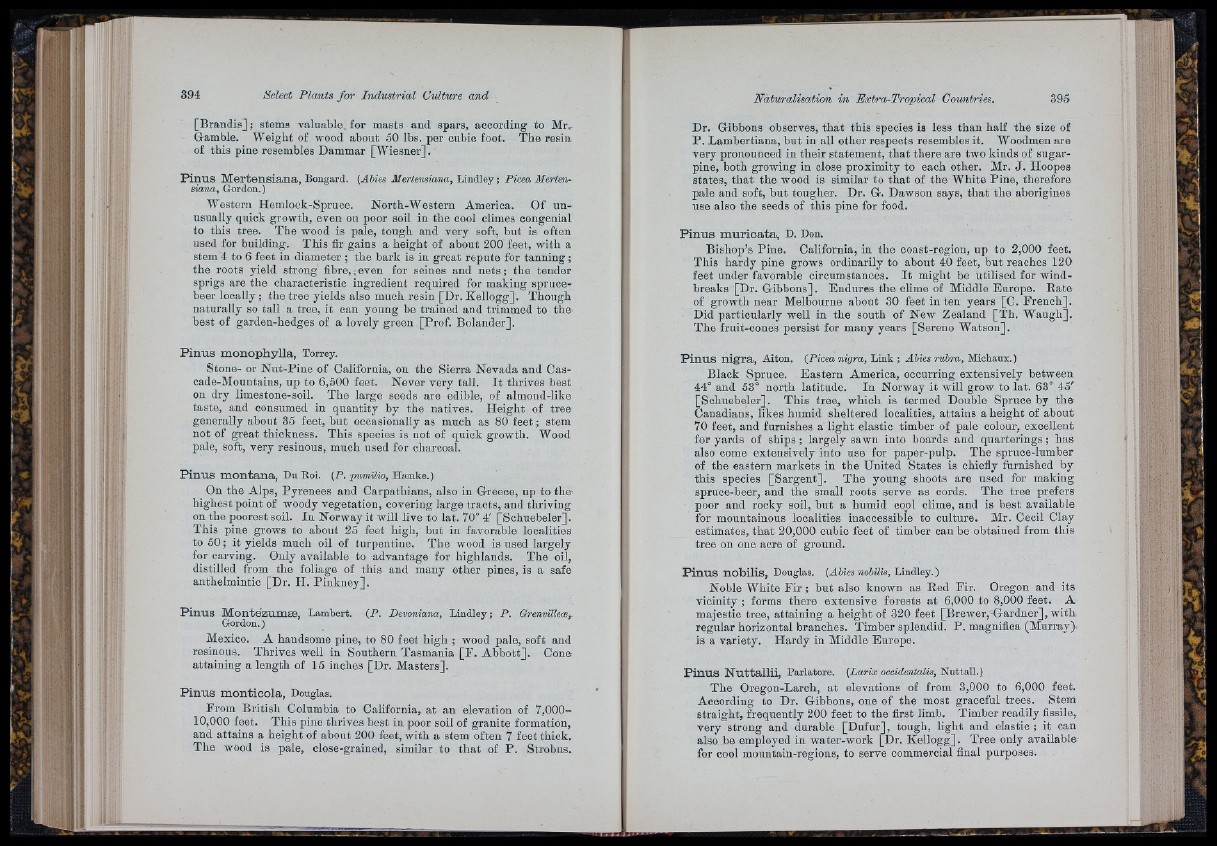
[B ran d is]; stems valuable for masts and spars, according to Mr.-
Gamble. Weight of wood about 50 lbs. per cubic foot. The resin
of this pine resembles Dammar [Wiesner].
Pinus Mertensiana, Bongard. (Abies M&rtensiana, Lindley; Picea Merten-
siana, Gordon.)
Western Hemlock-Spruce. North-Western America. Of unusually
quick growth, even on poor soil in the cool climes congenial
to this tree. The wood is pale, tough and very soft, but is often
used for building. This fir gains a height of about 200 feet, with a
stem 4 to 6 feet in diameter ; the bark is in great repute for tan n in g ;
the roots yield strong fibre, ¿even for seines and n e ts ; the tender
sprigs are the characteristic ingredient required for making spruce-
beer locally; the tree yields also much resin [Dr. Kellogg]. Though
naturally so tall a tree, it can young be trained and trimmed to the
best of garden-hedges of a lovely green [Prof. Bolander].
Pinus monophylla, Torrey.
Stone- or Nut-Pine of California, on the Sierra Nevada and Cas-
cade-Mountaius, up to 6,500 feet. Never very tall. I t thrives best
on dry limestone-soil. The large seeds are edible, of almond-like
taste, and consumed in quantity by the natives. Height of tree
generally about 35 feet, but occasionally as much as 80 fe e t; stem
not of great thickness. This species is not of quick growth. Wood
pale, soft, very resinous, much used for charcoal.
Pinus montana, Du Roi. (P. pumilio, Hsenke.)
On the Alps, Pyrenees and Carpathians, also in Greece, up to the-
highest point of woody vegetation, covering large tracts, and thriving
on the poorest soil. In Norway it will live to lat. 70° 4' [Schuebeler].
This pine grows to about 25 feet high, but in favorable localities
to 50; it yields much oil of turpentine. The wood is used largely
for carving. Only available to advantage for highlands. The oil,
distilled from the foliage of this and many other pines, is a safe
anthelmintic [D r. H. Pinkney].
Pinus Montezumte, Lambert. (P. Devoniana, Lindley; P. Grenvilleai,.
Gordon.)
Mexico. A handsome pine, to 80 feet high ; wood pale, soft and
resinous. Thrives well in Southern Tasmania [F . Abbott]. Cone
attaining a length of 15 inches [Dr. Masters].
Pinus monticola, Douglas.
From British Columbia to California, a t an elevation of 7,000-
10,000 feet. This pine thrives best in poor soil of granite formation,
aud attains a height of about 200 feet, with a stem often 7 feet thick.
The wood is pale, close-grained, similar to th a t of P . Strobus.
Dr. Gibbons observes, th a t this species is less than half the size of
P . Lambertiana, but in all other respects resembles it. Woodmen are
very pronounced in their statement, that there are two kinds of sugar-
pine, both growing in close proximity to each other. Mr. J . Hoopes
states, th a t the wood is similar to th a t of the White Pine, therefore
pale and soft, but tougher. Dr. G. Dawson says, th a t the aborigines
use also the seeds of this pine for food.
Pinus muricata, D. Don.
Bishop’s Pine. California, in the coast-region, up to 2,000 feet.
This hardy pine grows ordinarily to about 40 feet, hut reaches 120
feet under favorable circumstances. I t might be utilised for windbreaks
[Dr. Gibbons]. Endures tlie clime of Middle Europe. Bate
of growth near Melbourne about 30 feet iu ten years [C. French].
Did particularly well in the south of New Zealand [Th. Waugh].
The fruit-cones persist for many years [Sereno Watson].
Pinus nigra, Aiton. {Picea nigra. Link ; Abies rubra, Miohaux.)
Black Spruce. Eastern America, occurring extensively between
44° and 53° north latitude. In Norway it will grow to lat. 63° 45'
[Sohuebeler]. 'This tree, which is termed Double Spruce by tho
Canadians, likes humid sheltered localities, attains a height of about
70 feet, aud furnishes a lig h t elastic timber of pale colour, excellent
for yards of sh ip s ; largely sawn into boards and q u arterin g s; has
also come extensively into use for paper-pulp. The spruce-lumher
of the eastern markets in the United States is chiefly furnished by
this species [Sa rg en t]. The young shoots are used for making
spruce-beer, and the small roots serve as cords. The tree prefers
poor and rocky soil, but a humid cool clime, and is best available
for mountainous localities inaccessible to culture. Mr. Cecil Clay
estimates, th a t 20,000 cubic feet of timber can he obtained from this
tree on one acre of ground.
Pinus nobilis, Douglas. (Abies nobilis, lAadley.')
Noble White F ir ; hut also known as Red Fir. Oregon and its
vicinity ; forms there extensive forests at 6,000 to 8,000 feet. A
majestic tree, attaining a height of 320 feet [Brewer, Gardner], w ith
regular horizontal branches. 'Timber splendid. P . magnifica (Murray)
is a variety. Hardy in Middle Europe.
Pinus Nuttallii, Parlatore. (Larix occidentalis, Nuttall.)
The Oregon-Larch, a t elevations of from 3,000 to 6,000 feet.
According to Dr. Gibbons, one of the most graceful trees. Stem
straight, frequently 200 feet to the first limb. 'Timber readily fissile,
very strong and durable [Dufur], tough, light and elastic ; it can
also be employed in water-work [^Dr. K ellogg]. Tree only available
for cool mountain-regions, to serve commercial final purposes.